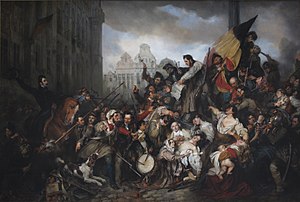Belgian independence
| Belgian Revolution | |||||||
|---|---|---|---|---|---|---|---|
| Part of the Revolutions of 1830 | |||||||
 Episode of the Belgian Revolution of 1830, Gustaf Wappers (1834), (Museum of Fine Art, Brussels) |
|||||||
|
|||||||
| Belligerents | |||||||
|
Supported by: |
|
||||||
| Commanders and leaders | |||||||
|
|
|
||||||
| Strength | |||||||
|
|
|
||||||
Belgian victory
The Belgian Revolution (French: Révolution belge, Dutch: Belgische Revolutie/opstand/omwenteling, German: Belgische Revolution) was the conflict which led to the secession of the southern provinces (mainly the former Southern Netherlands) from the United Kingdom of the Netherlands and established an independent Kingdom of Belgium.
The people of the south were mainly Dutch-speaking Flemings and French-speaking Walloons. Both peoples were traditionally Roman Catholic as contrasted with Dutch Protestants in the north. Many outspoken liberals regarded King William I's rule as despotic. There were high levels of unemployment and industrial unrest among the working classes.
On 25 August 1830 riots erupted in Brussels and shops were looted. Theatre goers who had just watched a nationalistic romanticist opera joined the mob. Uprisings followed elsewhere in the country. Factories were occupied and machinery destroyed. Order was restored briefly after William committed troops to the Southern Provinces but rioting continued and leadership was taken up by radicals, who started talking of secession.
Dutch units saw the mass desertion of recruits from the southern provinces, and pulled out. The States-General in Brussels voted in favour of secession and declared independence. In the aftermath, a National Congress was assembled. King William refrained from future military action and appealed to the Great Powers. The resulting 1830 London Conference of major European powers recognized Belgian independence. Following the installation of Leopold I as "King of the Belgians" in 1831, King William made a belated military attempt to reconquer Belgium and restore his position through a military campaign. This "Ten Days' Campaign" failed because of French military intervention. Not until 1839 did the Dutch accept the decision of the London conference and Belgian independence by signing the Treaty of London.
...
Wikipedia
